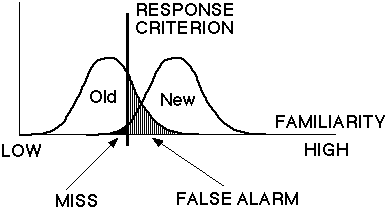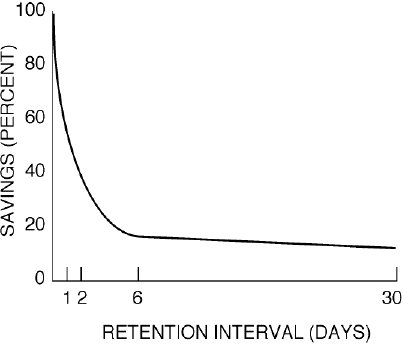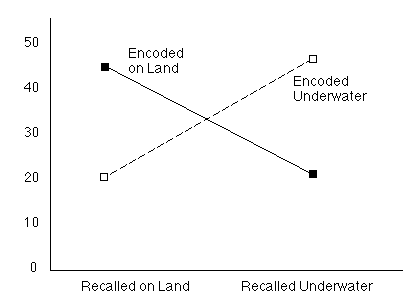
<<Back to Cognition Class Home Page
---------------------------------------------------------------------------------------
TYPES OF MEMORY (FIGURE ON IVRY BOOK)-------------------------------------------------------------------
EXPLICIT MEMORY
Semantic Memory: general knowledge, for example, vocabulary and rules of language,
Episodic Memory: Memory for events. (What is an event?)
-------------------------------------------------------------------
IMPLICIT MEMORY:
Two types of implicit memories are facilitation and rule learning.
Priming
Priming is a type of learning. When a stimulus, for example a word, a line drawing, or a photograph, is presented to people several times, the time to recognize the stimulus decreases with each repetition. Also recognition is improved when the person is given a degraded copy of the stimulus, such a fragment of the word or line drawing. Usually the person is not aware of this facilitation, and this is why this type of learning is referred as "implicit memory".
Rule learning
"Implicit acquisition of a rule system from an encounter with a set of stimuli generated according to those rules"
Implicit and explicit memory performance differs on several dimensions: (1) explicit memory performance tend to decrease with time, whereas implicit performance does not (or much less); (2) implicit memory performance does not change with age in children, whereas explicit memory performance increase with age.; (3) some drugs reduce explicit memory but does not effect implicit memory; (4) in amnesia, explicit memory is impaired, whereas implicit memory is intact; (5) neuroimaging study showed that explicit memory task activate the hippocampus, whereas implicit memory tasks (fragment completion) produce a deactivation of right posterior cortex.
-------------------------------------------------------------------
STAGES OF INFORMATION PROCESSING IN MEMORY
Encoding --> acquisition of information
Storage --> persistence of information
Retrieval --> re-activation of memory traces
-------------------------------------------------------------------
EXPERIMENTAL PARADIGMS
RECALL
Participants study a list of items. Usually after a certain interval, participants are asked to recall the items studied. Type of recalls include:
FREE recall, in which participants can report the studied items in any order, as they come to mind
CUED recall: the items are learned in pairs. One item in the pair is given in the recall phase, and participants have to recall the second item in the pair
RECOGNITION
Again, participants study a list of items. In the testing phase, a new list is presented. Part of the elements in the list are old items presented in the study phase, and part of the element in the list are new items (foils or distractors). Participants have to decide whether each test item is new or old.
Note that data from a recognition paradigm can be analyzed in the same way as data from a detection paradigm. We can compute the number of hit , false alarms, miss and correct rejection and use the signal detection theory to analyze participants' performance.

What is the difference between these two tasks? Would you predict a different performance in the two tasks?
-------------------------------------------------------------------
THE EBBINGHAUS RESEARCH
Two things are very famous in Ebbinghaus experiments. The material of Ebbinghaus' experiments was lists of nonsense syllables (e.g., qif, fon, cum, hos, leq) and the subject was himself.
There were serious reasons not to use meaningful material: Ebbinghaus wanted to study pure memory traces without the confounding effect of meaning. He realized that meaningful material was learned more easily than nonsense material. In particular, Ebbinghaus wanted to study how we learn NEW material, and of course meaningful material, such as words, is not NEW information, but information that we already learned.
Ebbinghaus was the first researcher to study memory in a rigorous and controlled way. His only experimental task was the relearning task, in which a list is originally learned, set aside for some period of time, then later relearned to the same criterion of accuracy (that is, one or two complete repetitions of the list without errors).
Relearning was measured through the savings method. The method consists of learning a list until perfect performance and then relearning the list at different intervals. Ebbinghaus noticed that he was faster in learning a list the second time than the first time. The saving score is computed as:
time for original learning - time for second learning
-----------------------------------------------------------------------------------------------------------
time for original learning.
The famous forgetting curve is the plot of the savings as a function of the retention interval, that is, the interval between the original learning and relearning.

Other results of Ebbinghaus were that overlearning (repeating a list after reaching the criterion) produces larger savings and that the time required to learn a list increases with the number of items in the list. A practical application of these results is that overlearning -- to repeat the material multiple times after perfect learning -- is very important when perfect learning without forgetting is required (for example, to learn a part for an actor).
-------------------------------------------------------------------
FREDERICK BARTLETT: RECONSTRUCTIVE MEMORY
The use of nonsense material prevented Ebbinghaus from studying the more creative and active aspects of memory. This is was the purpose of Bartlett's studies. His methodology was radically different from Ebbinghaus' methodology. Bartlett had subjects study the material for a period of time, then recall it several times, once shortly after study and then again at later intervals. By comparing participants' successive recalls, Bartlett examined the progressive changes in what his subjects remembered. In a famous experiment, Bartlett asked people to read an unusual Eskimo story ("The war of the ghosts") and to repeat it. Subjects were asked to remember the story after a certain interval of time. The stories remembered after a certain time were more concise and coherent, and had lost some of the more obscure or not logical elements. In particular, people tend to (1) OMIT minor details or particularly unusual aspect of the story and to (2) normalize and rationalize the content of the stories.
According to Bartlett, these results show that memory is not REPRODUCTIVE (passive repetition of the original event) but RECONSTRUCTIVE (recombination of elements from the original material together with pre-existing knowledge).
Bartlett proposed that people have certain knowledge structures, or SCHEMAS. A schema is a configuration of prototypical knowledge we have of familiar situations.
A dramatic demonstration of the effect of schemas on memory is the following (Bransford and Johnson, 1972). Read the story presented below and then, without watching at it, try to remember what you can about it.
"The procedure is actually quite simple. First you arrange things into different groups. Of course, one pile may be sufficient depending on how much there is to do. If you have to go somewhere else due to lack of facilities that is the next step, otherwise you are pretty well set. It is important not to overdo things. That is, it is better to do too few things at once than too many. In the short run, this may not seem important, but complications can easily arise. A mistake can be expensive as well. At first the whole procedure will seem complicated. Soon, however, it will become just another facet of life. It is difficult to foresee any end to the necessity for this task in the immediate future, but then one never can tell. After the procedure is completed one arranges the materials into different groups again. Then they can be put into their appropriate places. Eventually, they will be used once more and the whole cycle will then have to be repeated. However, that is part of life."
If I ask you to remember this story, probably you will able to recall few things. The different parts of the passage seem incoherent and arbitrary. However, if I tell you that the passage is entitled "Doing the Laundry" and you read again the passage your memory will be a lot better. The activation of the schema for washing clothes provides a way of generating cues for recalling the sentences and your memory improves quite a bit.
-------------------------------------------------------------------
HOW DO WE STORE INFORMATION IN LONG-TERM MEMORY?
There are three possible strategies that we can use to memorize events and new information: rehearsal, organization, and imagery.
REHEARSAL: We have already discussed Rundus study. He showed that, when participants were asked to remember a 20-item list, recall was better for items presented at the beginning of the list (primacy effect) and at the end of the list (recency effect). For our purpose, the important result of Rundus' experiment is that the probability of recalling an item in the primacy part of the list was proportional to the number of times that that item was rehearsed. Rundus concluded that rehearsal increases the probability that an item is stored in long term memory.
However, we also saw that Craik and Watkins (1973) demonstrated that pure rehearsal does not actually increase the probability that an item will be recalled. They proposed that two types of rehearsal exist: maintenance rehearsal, that does not improve memory, and elaborative rehearsal, that requires a deeper and/or richer encoding and does improve memory.
ORGANIZATION: We saw in the example above organizing material in the meaningful way dramatically improve recollection. We do this quite spontaneously. For example, Bousfield (1953) presented 60-item lists to his subjects. The list was made up of words belonging to four distinct categories (animals, names, vegetables, and professions) presented in random order. After the study phase, participants were give a free recall test. Participants tended to remember the items organized by categories ("dog, cat, cow, pea, bean, John, Bob").
Organization is essential to memory. Mandler (1967) suggested that other memorization strategies, such as rehearsal, are successful only when contribute to reorganizing the material to be remember, and the same is true for mnemonic techniques.
VISUAL IMAGERY: Paivio (1971) showed that, in a cued-recall task, participants performed twice as better when they were instructed to use an imagery strategy. For example, if the pair of items were elephant and book, participants were instructed to imagine an elephant with a book. Paivio proposed that each item in the list was encoded twice in the visual imagery condition: as a word (book, elephant) and a visual image (dual coding hypothesis). This richer encoding improves the probability that the item can be retrieved.
-------------------------------------------------------------------
HOW DO WE RETRIEVE INFORMATION FROM LONG-TERM MEMORY?
Even if we consider encoding and retrieval two different processes, the way in which we encode information is crucial for the probability of retrieval.
An essential concept in the memory literature is that of retrieval cue. When we retrieve information from our long-term memory, we use retrieval cues, that is, something that acts as a useful prompt or reminder for the information to be retrieved. The context in which the information was originally encoded is a powerful retrieval cue. The number of possible retrieval cues for a certain information can predict the probability that that information will be retrieved.
For example, we can explain the result that deep processing of information at encoding will produce a better memory than a shallow encoding, assuming that deep encoding is associated with a larger number of retrieval cues than shallow encoding.
Everyone has the embarrassing experience to go to the living room and forget why we went there. We also know that the best method to remember what we wanted to do is to go back to the bedroom, where we were before, and try to remember. And what about the difficulty to recognize a person when we see him/her in an unusual context?
This type of effect can be explained by he concept of encoding specificity. According to Tulving and Thompson (1973) each item is encoded into a reach memory representation that includes extra information about the item that was present during encoding.
Encoding specificity effect:
As we saw from Jennifer Freyd lecture, retrieval cues are powerful determinants of what we can recall and what we cannot recall. In less dramatic circumstances, the importance contextual retrieval cue has been shown by Godden and Baddeley (1975). Deep-sea divers were trained to memorize a list of words in two training environments: on land or in an underwater tank. Successively the divers were tested in the same context or in a different context. The results showed that recall was better when study and test phases where in the same environment than when they were in different environments.

Distinctiveness of cues
Last week I mentioned the generation effect: generating a word yields a better memory than simply reading the same word. This effect can be explained in terms of deeper processing, and therefore in terms of more retrieval cues. Mäntylä (1985) found an effect similar to the generation effect using a different experimental paradigm. He presented long list of words (600) in two conditions. In the first condition, participants were asked to generate one association for each word presented; in the other condition they were asked to generate three associations. In the recall phase, words generated in the study phase were used as recall cues. The results showed that in both cases retention was much higher that in the usual cued recall paradigm and that recall was almost perfect (~90%) in the "three associations" condition.
-------------------------------------------------------------------
WHY DO WE FORGET?
Decay
Decay was the first (and very intuitive)concept used to account for forgetting from long-term memory. Thorndike (1914) proposed that some information that is not often used just fades away, as we saw happens in sensory stores. However, this explanation has been found wrong. In particular, McGeoch strongly criticized this hypothesis.
"Forgetting could not be accounted for by disuse, if disuse means only passage of time, for time, in and or itself, is not a determining condition of events in nature. It is a conceptual framework in which activities go their ways and in term of which events are plotted. In time, iron may rust and men grow old, but the rusting and the aging are understood in terms of the chemical and other events which occur in time, not in terms of time itself."
So, if we want to understand forgetting, we cannot just propose that there is a decay over time: this is a description more than an explanation. We need to propose some active mechanism that can account for this decay.
Interference
A better explanation is that new information that we encounter may make retrieving old information more difficult (retroactive interference).
The experimental paradigm used to demonstrate interference is the paired associated learning. First, participants have to study a list of word pairs (A-B) until they reach a certain criterion of performance. Then a second list is studied and the dependent variable is the number of trials required to learn the second list (as in Ebbinghaus case). In the control condition, all the words in the second list are different from the first list (C-D). This condition is the baseline and measures what is the number of trials required to learn a list when not interference is expected. In the A-Br condition, the second list contains the same words as the first list, but in a new randomized pairing. Learning this type of list is much more difficult and requires a greater number of trials. This is because information learned in the previous study phase interfere with new learning (proactive interference). However, if you manage to learn the list A-Br and you are tested on the original A-B list, your performance will be really bad. New information interferes with the retrieval of old information (retroactive interference). The idea is that, to learn the second list, we need to "forget" or "unlearn" the first list.
Retrieval failure
A problem with interference theories is that they work fine with arbitrarily associated list of items used in the laboratory, but not with real-life material. In the previous example, if we also generate associates to the items of the first list (dog -> cat) and then we learn the second list, we still will be able to perfectly remember the associate that we generated at the beginning (Slamecka, 1966). Nothing seems to be "unlearned" or "forgotten".
The more modern theories of forgetting propose that we do not "forget" anything that we learned. However, we may be unable to retrieve it. As Tulving wrote: "information may be available even when it is not accessible".
Think of a common phenomenon, the tip-of-the-tongue phenomenon. We cannot remember a word, or the name of a person. However, we are usually able to access some information about it (the first letter, how long it is) and we can use this information as retrieval cue for the name we cannot remember.
According to this view, nothing is lost in long-term memory, and nothing decays. However, part of the stored information may not be accessible any more, because we don't know how to retrieve it, like a book in a library that has been displaced.
---------------------------------------------------------------------------------------